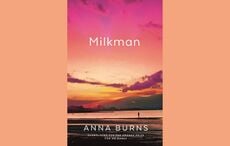If you’re looking for fairy tale Rural Ireland, “The Dirty Dust” (“Cré na Cille”) is not the place to start.
"The Quiet Man" it ain't.
Foul-mouthed insults, brutal family rivalries and gossip are essentially what this novel, a long overdue translation of one of Irish literature’s most famous novels “Cré na Cille,” is all about.
“If people want that they can go back to the old bog road or whatever,” says translator Alan Titley. “There’s lots of that available, from J. M Synge and Lady Gregory.”
“There are dozens of them there, but I think that it is demeaning to Irish people and demeaning to the language and totally unnecessary.”
Alan Titley is a novelist, story writer, playwright and scholar, a proud Corkman, and a lover of strong, energetic language.
He was approached by fellow Irish writer Micheál Ó Conghaile and persuaded to undertake the enormous task of translating Máirtín Ó Cadhain’s 1940s Irish language masterpiece, “Cré na Cille.”
“I would never have translated it only that Michael asked me,” he admits.
“The Dirty Dust” takes on an unusual and often complicated format. Every word comes from the mouth of a corpse, as the dead residents of a graveyard in 1940s Connemara, Co. Galway, continue the battles, backchat and back-stabbing by which they lived their lives above ground.
The plot-lacking novel defies standard structures, with readers left to guess who is speaking at any given time, in a mixed-bag of voices, subjects and stories mangled on top of each other.
Imagine the roar streaming from an unattended classroom packed with 15-year olds when a teacher has slipped out. That’s how I’d imagine the graveyard of "Cré na Cille" to sound.
Ó Cadhain, one of the most prominent Irish language writers of the 20th century, created a work in Irish that took from all dialects of the language, from other related languages such as Scots Gaelic and even made up his own vocabulary. “Cré na Cille” is held in such acclaim that Titley tells how Tomás De Bhaldraithe, of English-Irish dictionary fame, recommended that students return to it at least once a year. As such, it’s a daunting task for any translator.
“How could you recreate the English of Galway in the 1940s?” he asks.
“Nobody did speak English and, if they did, then it would have been broken English.
“They weren’t speaking a broken speech [in “Cré na Cille”], they were speaking a speech that was complete and full and thorough.”
One of the most important aspects of “The Dirty Dust,” is the manner in which it copes with representing a modern idea of Irish and avoiding this broken speech.
The debate is something Titley is very passionate about, further berating the likes of J.M. Synge and the Anglo-Irish used throughout such work.
“There’s thousands of years of talk behind it [the Irish used in “Cré na Cille”],” he says. “So you couldn’t give it that broken peasant quality, something that I was determined not to do.”
“I was trying to make the English as rich as the Irish was, and I was trying to match it in some kind of sense along the way.“
Of the several hundred Irish novels published in the past century, only ten have been translated to English, a common trend in most languages. “English doesn’t do that,” Titley explains. “About 3% of published books in English are translations, so in that sense, there’s nothing unusual.”
“I was willing to take on the translation so that this famous novel, the best novel or the most notoriously famous novel in Irish, would be available to people who were never going to know Irish, and had probably no inclination to learn it, but at the same time were aware that it was there.”
As with any translation, Titley has left his own character within the English used, especially in his decision to leave aside the Anglo-Irishness of other works and to focus on the English he encounters everyday.
“You don’t have to introduce a foreignness into it,” he believes. “You know that this novel is set in Ireland, set in Connemara.
“You know by the people’s names, you know by the placenames. You don't have to do any more than that. When I read a novel translated from Russian or Arabic, I don’t want to get an Anglo-Arabic kind of language in it. I don't want to see whatever the strange grammatical fixations of Russian are put into English.”
“I want to read a novel.”
This redefining of rural Ireland and the peasant language used has been something of a life’s mission for Titley. He explains that TV and radio have filtered out this kind of speak. “I’m not saying it’s completely dead,” he admits. “There are, of course, some hillbillies, some troglodytes who will still speak this way because they know nothing better but, apart from that, no it doesn’t [exist].”
An accomplished playwright, he wrote a play called “An Ghráin agus an Ghruaim” (“Hatred and Gloom”) that attempted to include every disgusting and dirty thing that ever happened in rural Ireland. From people urinating in buckets and pigs being killed to, as he puts it, “certain things happening with sheep,” Titley strove with this “fairly vicious play” to drive off the likes of J. M. Synge and Lady Gregory forever.
He was not quite so lucky, and further playwrights, such as Martin McDonagh, followed with a return to the Anglo-Irish peasantry that Titley despises. “I think there’s something endemic within us that wants that,” he says.
“It’s also interesting that somebody like Peig Sayers [a famous Irish language author from Kerry and writer of "Peig," the infamous portrayal of life on the failing Blasket islands] is mocked. When people look at the part of the peasant in Irish, they say, ‘that’s terrible, we hate that, that’s a reminders of who we were,’ but if you put that into English like Synge and Martin McDonagh: ‘great, we love that!’”
For Titley, this obsession with Synge and McDonagh (who he still respects as a good playwright) results in the exclusion of other good Irish works, which simply don’t meet the dream-like quaint pleasant Ireland criteria.
He mentions the work of Hugh Leonard, which he feels is overlooked because it deals with Dublin and with ordinary middle-class people.
“But there’s nothing Irish about that!” he exclaims.
"Cré na Cille" (Graveyard Clay) (clip) - Director Robert Quinn from oneword on Vimeo.
He would even go as far as to say that we should be concentrating on good Irish chick-lit just as much as ‘Romantic Ireland, and laments the exclusion of chick-lit from Irish literature courses. ’
“We will do novels by J. B. Keane,” he argues, “but you wouldn’t get anything about good chick-lit, and there is good chick-lit, which is about ordinary stuff which is happening.
“That doesn’t seem very Irish – Marian Keyes or whatever – because that’s just like anything else, anywhere else. There’s a sense in which we want the Irishness to stick out in some way, it doesn’t really matter what way that is.
It took Titley just 15 months to complete the translation. Already well-read on Máirtín Ó Cadhain, having written a Master’s thesis on his bibliography and having dealt with his other works, Titley listened to an audio version of the book brought out by Cló Iar-Chonnachta a few years ago. He jokes that he was forced to listen to a lot of other radio from his native Cork also, so the Galway Irish of “Cré na Cille” would not contaminate his own.
“The big difficulty was simply getting the tone of voice at the beginning,” he admits.
“I did it in as literary a way as I could, but the tone of voice and the sense of expectation and the energy was mine more than anything else.”
Titley’s own character and love for language is evident, in what is now his own masterpiece translation. His GAA rivalries crop up while we talk, and he admits that one of the only artistic liberties he took throughout the novel is an over exaggerated emphasis on just how badly Kerry would lose to Galway. A Corkman always loves to see Kerry lose.
It wasn’t just the language itself that would present difficulties in translation but the confused interaction of the novel’s characters also. Thinking back on his own children helped, somehow, in dealing with the cacophony of voices beneath the soil. “My mother had six sisters,” he reveals. “Two of them immigrated to America, two to England and two stayed in Cork.”
“Every summer, they would come home … I was there as a young fella listening to these and what struck me was nobody was listening to anybody else. They were all talking. This talk was going on and on and on and on.
“It’s only as I was going through the book I said, ‘it reminds me of what my mother’s sisters were like.
“There was a sense of talk, talk, talk, talk, conversations going on at different levels and not everybody knowing, not everybody following, what was going on.”
And what will “The Dirty Dust” mean for Irish (language) literature in the face of the ever-present threat and hatred from certain non-speakers?
“If it does anything else it will show people that there is a substantial body of it,” Titley hopes.
“It is a great novel, it is a classic … In so far as to learn about that, it may get them to just scratch their heads a little bit and in that sense it can only do good.”




Comments